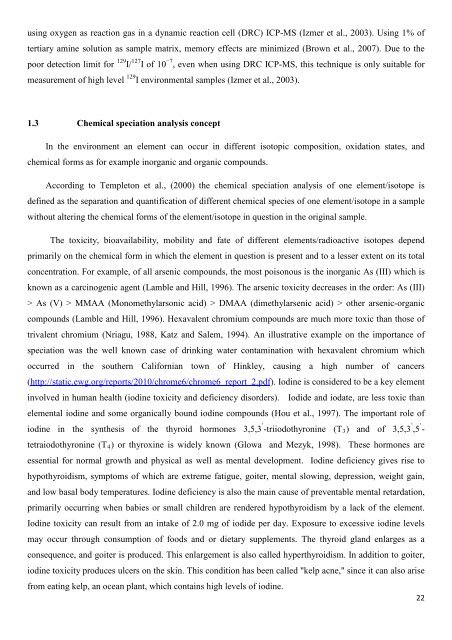Thesis for the Degree of Doctor of Philosophy - DTU Orbit
Thesis for the Degree of Doctor of Philosophy - DTU Orbit
Thesis for the Degree of Doctor of Philosophy - DTU Orbit
Create successful ePaper yourself
Turn your PDF publications into a flip-book with our unique Google optimized e-Paper software.
using oxygen as reaction gas in a dynamic reaction cell (DRC) ICP-MS (Izmer et al., 2003). Using 1% <strong>of</strong><br />
tertiary amine solution as sample matrix, memory effects are minimized (Brown et al., 2007). Due to <strong>the</strong><br />
poor detection limit <strong>for</strong> 129 I/ 127 I <strong>of</strong> 10 −7 , even when using DRC ICP-MS, this technique is only suitable <strong>for</strong><br />
measurement <strong>of</strong> high level 129 I environmental samples (Izmer et al., 2003).<br />
1.3 Chemical speciation analysis concept<br />
In <strong>the</strong> environment an element can occur in different isotopic composition, oxidation states, and<br />
chemical <strong>for</strong>ms as <strong>for</strong> example inorganic and organic compounds.<br />
According to Templeton et al., (2000) <strong>the</strong> chemical speciation analysis <strong>of</strong> one element/isotope is<br />
defined as <strong>the</strong> separation and quantification <strong>of</strong> different chemical species <strong>of</strong> one element/isotope in a sample<br />
without altering <strong>the</strong> chemical <strong>for</strong>ms <strong>of</strong> <strong>the</strong> element/isotope in question in <strong>the</strong> original sample.<br />
The toxicity, bioavailability, mobility and fate <strong>of</strong> different elements/radioactive isotopes depend<br />
primarily on <strong>the</strong> chemical <strong>for</strong>m in which <strong>the</strong> element in question is present and to a lesser extent on its total<br />
concentration. For example, <strong>of</strong> all arsenic compounds, <strong>the</strong> most poisonous is <strong>the</strong> inorganic As (III) which is<br />
known as a carcinogenic agent (Lamble and Hill, 1996). The arsenic toxicity decreases in <strong>the</strong> order: As (III)<br />
> As (V) > MMAA (Monomethylarsonic acid) > DMAA (dimethylarsenic acid) > o<strong>the</strong>r arsenic-organic<br />
compounds (Lamble and Hill, 1996). Hexavalent chromium compounds are much more toxic than those <strong>of</strong><br />
trivalent chromium (Nriagu, 1988, Katz and Salem, 1994). An illustrative example on <strong>the</strong> importance <strong>of</strong><br />
speciation was <strong>the</strong> well known case <strong>of</strong> drinking water contamination with hexavalent chromium which<br />
occurred in <strong>the</strong> sou<strong>the</strong>rn Cali<strong>for</strong>nian town <strong>of</strong> Hinkley, causing a high number <strong>of</strong> cancers<br />
(http://static.ewg.org/reports/2010/chrome6/chrome6_report_2.pdf). Iodine is considered to be a key element<br />
involved in human health (iodine toxicity and deficiency disorders). Iodide and iodate, are less toxic than<br />
elemental iodine and some organically bound iodine compounds (Hou et al., 1997). The important role <strong>of</strong><br />
iodine in <strong>the</strong> syn<strong>the</strong>sis <strong>of</strong> <strong>the</strong> thyroid hormones 3,5,3<br />
22<br />
’ -triiodothyronine (T3) and <strong>of</strong> 3,5,3 ’ ,5 ’ -<br />
tetraiodothyronine (T4) or thyroxine is widely known (Glowa and Mezyk, 1998). These hormones are<br />
essential <strong>for</strong> normal growth and physical as well as mental development. Iodine deficiency gives rise to<br />
hypothyroidism, symptoms <strong>of</strong> which are extreme fatigue, goiter, mental slowing, depression, weight gain,<br />
and low basal body temperatures. Iodine deficiency is also <strong>the</strong> main cause <strong>of</strong> preventable mental retardation,<br />
primarily occurring when babies or small children are rendered hypothyroidism by a lack <strong>of</strong> <strong>the</strong> element.<br />
Iodine toxicity can result from an intake <strong>of</strong> 2.0 mg <strong>of</strong> iodide per day. Exposure to excessive iodine levels<br />
may occur through consumption <strong>of</strong> foods and or dietary supplements. The thyroid gland enlarges as a<br />
consequence, and goiter is produced. This enlargement is also called hyperthyroidism. In addition to goiter,<br />
iodine toxicity produces ulcers on <strong>the</strong> skin. This condition has been called "kelp acne," since it can also arise<br />
from eating kelp, an ocean plant, which contains high levels <strong>of</strong> iodine.

















